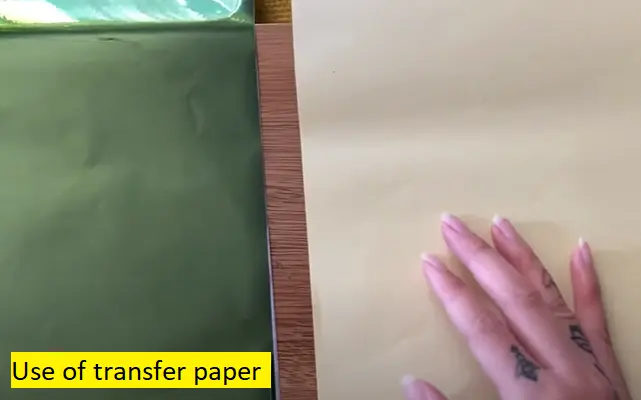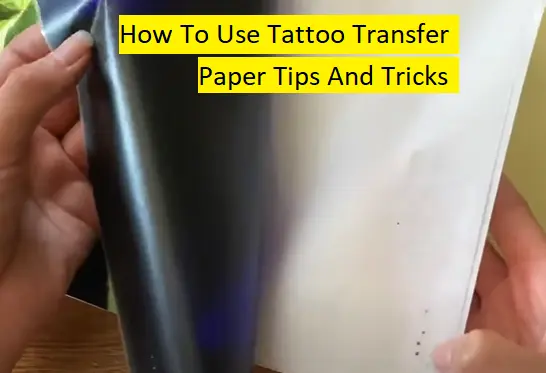How To Use Tattoo Transfer Paper
We know tattoos are a trend nowadays; if you see a tattoo design on any friend or anyone’s body, you wish it might be on your body. Here, we come up with a technique, if you need to become more familiar with it, that’s used to transfer tattoo designs; it’s called tattoo transfer paper.
Every tattoo artist should have tattoo transfer paper since it enables them to make precise stencils for their designs. With this paper, the tattoo artist may transfer a design from the paper to the skin before starting the tattooing procedure. This article will cover the numerous kinds of tattoo transfer paper, how to use tattoo transfer paper, and how to utilize them for optimal results. It also explains how to use stencil paper to transfer a tattoo design on the skin. Further, if you want to know about making a tattoo stencil, you can check out our recent article.
What is Tattoo Transfer Paper
Tattoo artists utilize tattoo transfer paper, a unique type covered with waxy pigments, to transfer patterns onto a customer’s skin. The paper aims to outline the upcoming tattoo by moving ink from the stencil’s design onto the skin’s surface.
The design on the skin surface is transferred using the transfer paper by applying heat or pressure. When applied face down, the tattoo transfer paper adheres to waxy pigments to the skin. The design leaves a trace on the skin after removal, giving the artist a starting point.
Types of Tattoo Transfer Paper
Three transfer papers are available to tattoo artists: hand-drawn, carbon, and inkjet printers. Knowing the differences between each kind might help you choose the ideal transfer paper for your project, as each has specific benefits and drawbacks.
1. Hand-Drawn Transfer Paper: This transfer paper transfers the pattern into the skin using a hand-drawn stencil created by the artist and a specially made solution for tattoo artists who like employing conventional techniques; this kind of paper is helpful.
2. Carbon Transfer Paper: A layer of carbon ink is first applied to the tissue paper for the design to be transferred onto the skin using this transfer paper. Carbon transfer paper is perfect for tiny tattoo designs or tattoo artists who prefer hand-drawn artwork.
3. Inkjet Transfer Paper: Artists may print designs from their computers onto paper using this transfer paper. The drawings are then applied to the skin using stencils, which speed up and improve the procedure considerably.
how to use tattoo transfer paper

An accurate tattoo stencil must be made using knowledge, equipment, and expertise. Here is a step-by-step tutorial for utilizing thermographic paper to create tattoo stencil paper.
Step 1: Choose Your Transfer Paper
Choose a transfer paper appropriate for the design and the method you want to employ. The paper must transfer the ink to the skin’s surface without smearing or shifting.
Step 2: Choose Your Tattoo Design
Selecting the image you wish to transfer to the skin comes next. The design can be created from scratch, downloaded from the internet, or used as is. You can improve the design or make modifications to meet the client’s requirements.
Step 3: Print the Tattoo Design
The 3rd step is printing your design using a stencil machine and tattoo transfer paper.
Step 4: Apply the Transfer Paper onto the Skin
Apply the transfer side of the transfer paper to the skin surface. To adhere to the transfer paper to the skin’s surface, use a transfer gel or similar technique. To prevent smearing, make sure the transfer paperwork is still in place throughout the transfer process.
Step 5: Peel Off the Transfer Paper
Once the transfer has been completed, remove the transfer paperwork. The artwork should be discernible on the skin’s surface so the artist may use it to make any required alterations or revisions.
Method 2: transferring images onto crafts
Here is a step-by-step guide on how to use tattoo transfer paper by the method of transferring images onto crafts:
1. Select the picture you want to print on your craft. Verify that the picture is the appropriate size and layout for the project you intend to use.
2. Cut the tattoo transfer paper piece to the right size for your picture. The paper should be towards the glossy, ink-receiving side.
3. Make sure the picture is centered before placing it face-down on the transfer paper.
4. Apply pressure while you trace the shape of your picture with a pencil to ensure it is successfully transferred to the paper. Ensure that every line is accurately traced.
5. Lift the picture and transfer the paper to ensure the image has been accurately transferred onto the paper.
6. Make sure the transfer paper is level and centered before placing it on the craft surface you want to use to transfer the picture.
7. Using a tool like a bone folder, push down on the transfer paper to make sure the image is transferred to the craft surface.
8. Lift the transfer paper off the craft gradually so you can see the transferred picture.
9. Let the transferred image completely dry before completing the project, such as by painting or adding further embellishments.
how to use tattoo transfer paper without a thermal copier
Without a thermal copier, you can still utilize tattoo transfer paper; we’ll show you how. Three layers of paper make up the tattoo transfer paper.
The tattoo design is drawn on the top layer. The second layer is tissue paper that must be peeled off before usage, and the third layer is carbon paper that will be used to copy your design.
After removing the second tissue paper layer, you sketch the tattoo transfer onto the thermal paper, which is replicated onto the third layer.
The paper template must first be cut off to apply the tattoo to the skin. Use tattoo stencil lotion or roll-on deodorant to ensure the design stays on the skin. The tattoo outline will then be applied to the skin, giving you a clear idea of how the finished tattoo will appear.
How does tattoo transfer paperwork?
Tattoo transfer paper transfers the carbon ink from the stencil sheet onto it, which is subsequently put on the client’s skin. The tattoo artist may more precisely and correctly tattoo the design by employing this transfer procedure to produce an exact design outline on the client’s skin.
1. Using a stencil sheet, the artist either picks or produces a design. The stencil essentially serves as the final application of the tattoo’s outline to the client’s skin.
2. The transfer paper’s carbon side is positioned over the stencil sheet, and the two are then passed through a thermal copier. The original pattern is reversed when the machine warms up and the carbon on the stencil sheet transfers to the transfer paper.
3. After cleaning the client’s skin, the transfer paper is put face down to the targeted area. The pattern is then transferred to the skin by the artist applying pressure to the transfer paper.
4. After the transfer, the paper is removed, allowing the tattoo artist to cover the transfer lines. This makes it possible to generate a clear and exact outline of the design on the skin, which makes it simpler for the tattoo artist to apply the design precisely.
FAQs
Conclusion
Tattoo transfer paper is a very efficient technique for constructing a tattoo stencil and transferring patterns onto the skin. Tattoo artists can select from various transfer papers that suit their unique requirements. Tattoo artists may design top-notch tattoo stencils that produce precise tattoos by following the necessary procedures, which include choosing the appropriate transfer paper, applying the paper correctly, and peeling off the paper. A high-quality tattoo transfer paper needs to be in your tattoo artist toolbox.
This study reveals how to use tattoo transfer paper. If you have further confusion, you’re welcome. Enjoy tattooing!

